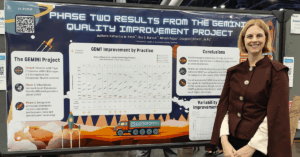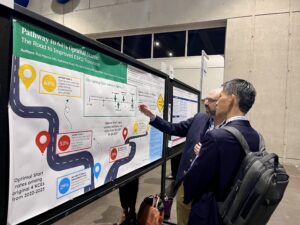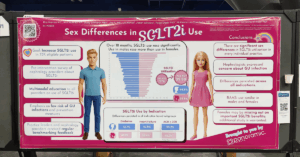From Data Dump to Dialogue: Redesigning the Modern Research Poster
Walk into any large medical conference and you will see hundreds, sometimes thousands of posters vying for attention. Many are packed with text and overwhelming; a visual wall of data that even the most engaged attendee struggles to absorb.

Dr. Katherine Kwon, partner physician at Lake Michigan Nephrology and Vice President of Clinical Affairs for Panoramic Health, is challenging that status quo. After years of presenting and reviewing posters, she believes the traditional format is broken. She’s seen first-hand how even high-quality research can get lost in the shuffle when posters fail to guide viewers to the core message.
“People fundamentally misunderstand what a poster is meant to do,” she explains. “They just create a large, printed version of their published abstract. They don’t think about how posters convey information. They aren’t meant to be enduring. When people snap photos of a poster, they’re bookmarking an idea. I really doubt they’re going to zoom in tight to read a reference.”
Her solution is a design philosophy that treats research posters as storytelling tools, stripping away clutter to highlight the message that truly matters.
Posters as Conversation Starters
Dr. Kwon’s approach flips the traditional poster model on its head. A poster is not meant to hold every reference, method, or data point. Instead, her team treats posters as a way to spark curiosity and help viewers quickly understand the research and why it matters.
Posters are “really a sign you’re holding up saying, ‘Hey, I did this cool thing, come and talk to me about it,’” she explains. The goal is to distill the work into a few key points and visuals that draw viewers in, leaving the deeper dives for the presenter. This approach is well supported by the newer e-poster function, where additional information can be accessed using a QR code on the poster.

The stripped down format requires designers to let go of the instinct to cram everything onto a single board, a challenge many early-career researchers likely know all too well. Dr. Kwon recalls her own early posters, filled with dense paragraphs and a myriad of tables, which sometimes led viewers down “rabbit holes” and away from the main message.
With only a few seconds to capture attention, first impressions can determine whether your work is noticed or overlooked. Visual clarity, a central figure or graph, and concise messaging make a poster effective. Dr. Kwon also practices how she will present her poster verbally, making sure the design supports the story she wants to tell.
“The poster should be your visual entry point,” she says. “If the main point is something people want to engage with, then the presenter and the e-poster can dig into the details.”
A Thoughtful, Iterative Design Process
Dr. Kwon approaches poster design as a thoughtful, iterative process. She starts by getting all her ideas down on paper and then cuts, trims, and refines repeatedly until the essence of the message is clear. “Some start from a totally blank slate and then just cautiously add,” she says. She instead prefers to “start with the whole big thing and then take stuff away.”
Designing an engaging poster is often a team effort, especially when multiple authors are involved. While Dr. Kwon leads the vision, she and her colleagues carefully review the poster, considering everything from text to graphics, to make sure all the details support clarity, engagement, and the overall message.
 She also draws on familiar visual cues when it helps the message land. Dr. Kwon’s most recent poster at ASN Kidney Week drew inspiration from Mattel’s classic Barbie doll packaging. Even if you didn’t play with Barbies as a kid, the visual language is instantly recognizable, she explains. The theme guided the layout, font emphasis, and simplified text boxes, helping viewers grasp the main points immediately without getting lost in paragraphs of text. By focusing on these visual elements, Dr. Kwon ensures that her posters do more than convey information; they capture attention and invite conversation.
She also draws on familiar visual cues when it helps the message land. Dr. Kwon’s most recent poster at ASN Kidney Week drew inspiration from Mattel’s classic Barbie doll packaging. Even if you didn’t play with Barbies as a kid, the visual language is instantly recognizable, she explains. The theme guided the layout, font emphasis, and simplified text boxes, helping viewers grasp the main points immediately without getting lost in paragraphs of text. By focusing on these visual elements, Dr. Kwon ensures that her posters do more than convey information; they capture attention and invite conversation.
Encouraging a Mindset Shift
Not everyone immediately embraces Dr. Kwon’s approach. Some colleagues still favor the traditional, text-heavy poster format. But positive reactions often speak for themselves: many viewers are drawn in by the simplicity and creativity, and once engaged, they care about the findings and their implications.
“If your big thing is you don’t want any controversy, then do the same poster format as everybody else,” she notes. But the risk of blending in is that important research gets overlooked. Her advice? Focus on rigor, clarity, and impact, and don’t be afraid to stand out.
She admits some people may dislike it, but blanket acceptance is not her goal. The important thing is whether the science is rigorous and the message is important. “If I can say yes to that, then I am fine with people disagreeing with me on the aesthetics.”
Dr. Kwon encourages researchers to stand by their design choices while focusing on making the research accessible and engaging. With thousands of posters presented at conferences like Kidney Week, standing out makes a difference. A well-designed poster doesn’t just display data; it draws people in, starts conversations, and opens opportunities for collaboration.
A Culture of Collaboration and Innovation

Dr. Kwon ties this philosophy back to Panoramic Health’s collaborative network. “We’re all sharing our best practices. We’re encouraging and driving each other to be better,” she says. This peer-driven culture not only enhances clinical practice but also shapes how research is shared. “We get how to communicate with our peers,” she adds, ensuring that posters aren’t just informative, but engaging.
Beyond attention-grabbing visuals, she stresses that the mission to build a better poster is also a chance to tell a better story about how we’re innovating for patients. The ultimate goal is not just to stand out at a conference, but to inspire meaningful conversations that can influence care and collaboration.
By rethinking research posters in this way, Dr. Kwon shows how thoughtful design can transform how science is communicated and appreciated, ensuring important work captures attention and drives impact.
About Panoramic Health
Panoramic Health is kidney care’s leading integrated provider group, supporting a network of aligned nephrology practices across the U.S. treating hundreds of thousands of patients. Our mission is to slow disease progression and improve quality of life by empowering nephrologists with state-of-the-art clinical, operational, and financial solutions.
Founded by nephrologists, for nephrologists, Panoramic Health has a deep commitment to preserving clinical autonomy while supporting practice growth and reducing administrative burden. Our integrated model is built around the needs of complex kidney patients and enables partner practices to enhance care quality, reduce total cost of care, and access new revenue opportunities.